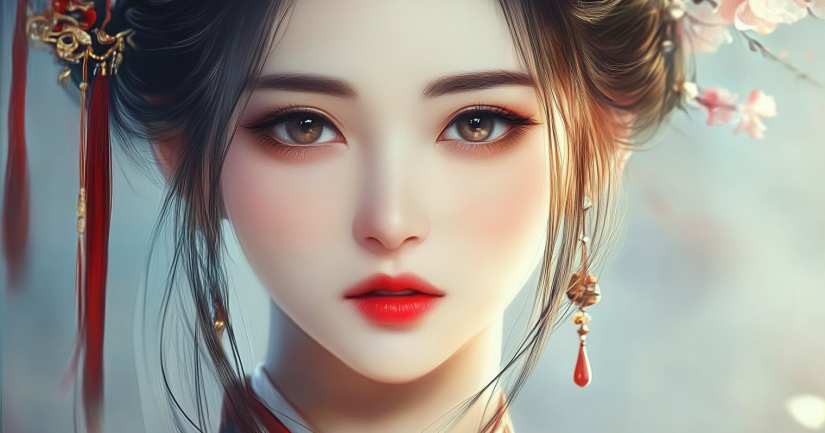
Experience the evolving ideals of beauty in Chinese culture with our Chinese Beauty Standards Quiz, Explore Traditional and Modern Ideals of Beauty in China. The Chinese Beauty Standards Quiz examines how beauty ideals have evolved in China, blending ancient traditions with modern influences. Chinese beauty standards emphasize harmony, elegance, and refinement, with preferences shaped by Confucian values, historical aesthetics, and global trends. From imperial court beauty ideals to today’s evolving fashion and cosmetic industry, these standards reflect both cultural heritage and changing societal values. This quiz will test your knowledge of traditional and contemporary Chinese beauty trends, ideals, and their historical significance.
Traditional Chinese beauty standards, especially during imperial dynasties, valued pale skin, delicate features, and graceful movement. Pale skin was associated with nobility, as working-class individuals typically had tanned complexions from outdoor labor. Women in the Tang Dynasty (618–907 CE) were admired for their fuller figures, while later dynasties, like the Ming (1368–1644 CE), favored slender silhouettes and refined facial features. Practices such as blackened teeth, high arched eyebrows, and elaborate hairstyles were seen as fashionable among aristocratic women.
Dive deeper into cultural aesthetics with the dramatic and emotional Chinese Drama Quiz. Or learn about beauty in everyday customs through the insightful Chinese Culture Quiz. If this quiz made you smile you’ll definitely want to check out What Chinese Element Am I Quiz for a zany twist. You’ll daydreaming as you compare your results and maybe see how zany life can be. Then saunter over to Chinese Zodiac Personality Quiz and discover something equally zany.
Try Out the Chinese Beauty Standards Quiz
Ancient Chinese Beauty Ideals: Grace, Poise, and Delicacy
The Influence of Foot Binding on Beauty Perceptions
For centuries, foot binding symbolized beauty and status in China. Beginning during the Song Dynasty (960–1279 CE), this practice involved tightly wrapping young girls’ feet to restrict growth, creating the ideal “three-inch golden lotus” shape. Small feet were considered highly attractive and a sign of refinement.
Traditional Beauty Rituals and Cosmetics in Ancient China
Chinese women historically used natural ingredients for skincare and cosmetics. Pearl powder, white rice water, and herbal infusions were common treatments for maintaining fair, smooth skin. Rouge, made from safflower petals, was used to create a soft blush on the cheeks and lips, while charcoal or ink was applied to define eyebrows. Perfumed floral powders added fragrance to the skin and hair. Many of these ancient beauty practices continue to inspire modern skincare trends in China today.
Modern Chinese Beauty Standards: The Rise of Global Influences
Today, beauty ideals in China have shifted, incorporating Korean, Japanese, and Western influences. Features such as large eyes, V-shaped jawlines, high nose bridges, and fair skin remain highly desirable. The “Xiaojiu face” (delicate, doll-like face) and “Guochao beauty” (national trend beauty) highlight a growing appreciation for traditional Chinese aesthetics blended with modern trends. Cosmetic procedures such as double eyelid surgery, rhinoplasty, and jawline contouring have gained popularity, reflecting shifting beauty expectations.
The Impact of Social Media and Celebrity Culture
Social media platforms like Weibo, Xiaohongshu, and Douyin (China’s TikTok) play a significant role in shaping beauty trends. Influencers and celebrities, including Fan Bingbing, Angelababy, and Liu Yifei, set the standard for fashionable looks. The “Wang Hong” (internet celebrity) aesthetic, characterized by flawless skin, soft makeup, and digital filters, dominates online beauty culture. These trends fuel China’s booming cosmetic and skincare industries, making beauty a multi-billion-dollar market.
Regional Beauty Differences Across China
China’s beauty standards vary by region. Northern Chinese beauty is often associated with tall stature, high cheekbones, and strong features, while southern Chinese beauty favors petite frames, soft features, and youthful appearances. In cities like Shanghai and Beijing, professional, elegant beauty styles dominate, while in Chengdu and Hangzhou, trendy, natural aesthetics are more popular. These regional variations highlight China’s diverse interpretations of beauty.
How Well Do You Know Chinese Beauty Standards?
Chinese beauty ideals have evolved from imperial elegance to modern global trends, shaping fashion, skincare, and self-perception. Whether you’re curious about traditional beauty rituals or the latest social media trends, this quiz will challenge your knowledge of Chinese beauty culture. Take the Chinese Beauty Standards Quiz to see how much you know about the evolving definition of beauty in China!
China Quizzes – Explore the Wonders …
Chinese Beauty Standards – FAQ
Traditional Chinese beauty standards often emphasize pale skin, slender figures, and delicate facial features.
Over time, Chinese beauty standards have evolved significantly. While traditional ideals persist, modern influences have introduced new elements such as the appreciation for taller statures and more diverse body types. Globalization and media exposure have played key roles in shaping these contemporary trends.
Technology, particularly social media and digital beauty apps, plays a substantial role in shaping current Chinese beauty standards. These platforms often promote specific aesthetics, enabling users to experiment with their looks and access beauty trends from around the world, thus broadening the scope of beauty ideals.
The concept of beauty in China significantly influences consumer behavior, particularly in the cosmetics and fashion industries. Many consumers prioritize products that promise to enhance features aligned with popular beauty ideals, driving demand for skincare products that promote fair skin and cosmetics that highlight delicate features.
Yes, there are cultural movements in China challenging traditional beauty standards. Increasingly, individuals and groups advocate for body positivity and self-acceptance, encouraging diversity and the celebration of unique features. These movements aim to redefine beauty by promoting inclusivity and personal authenticity.
